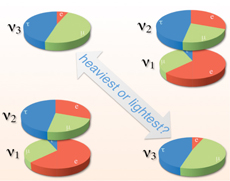Mind over matter at NOνA
 |
|
Scientists know that there are three types of neutrinos but they don't know which is the heaviest. Image courtesy of NOνA |
Neutrinos may not be faster than light, but their curious shape-shifting properties might be the reason matter exists in the universe.
"Equal parts of matter and anti-matter should have been produced in the big bang and then annihilated each other, leaving just a sea of photons," said neutrino physicist David Schmitz, PPD. "But we exist, which means there must have been something that tipped the scale in favor of matter. Neutrinos might be the answer, and, to find out, we need to make extremely detailed measurements of the phenomenon of neutrino oscillations."
Several experiments at Fermilab are designed to scrutinize the curious properties of neutrinos. One is the NuMI Off-Axis νe Appearance Experiment, which will use advanced detection techniques to watch for neutrino shape shifting, or oscillations.
Neutrinos exist as three different types, or flavors: electron neutrino (νe), muon neutrino (νμ) and tau neutrino (ντ). Initially, scientists suspected these neutrinos were three autonomous particles—the little brothers of the electron, muon and tau respectively. But results revealed that neutrinos oscillate between the three different flavors.
At Fermilab, the Main Injector Oscillation Search (MINOS) has been studying how muon neutrinos change into other forms since 2005. Along with other experiments elsewhere, it has found that they change primarily into tau neutrinos with a small fraction changing into electron neutrinos. The NOνA experiment will continue these measurements with much more precision.
The NOνA project was conceived ten years ago at Fermilab and has evolved into a collaboration among 152 scientists from 25 institutions. It uses the same principles as the MINOS experiment but takes the science to the next level.
"Like MINOS, NOνA uses the NuMI beam to generate neutrinos and then a near and far detector to observe their properties," said Paul Derwent, the NOνA associate project manager. "The difference is that the NOνA experiment is more sensitive and optimized to look at the neutrinos that are most likely to undergo the muon neutrino to electron neutrino oscillation."
Read more
—Sarah Charley
|